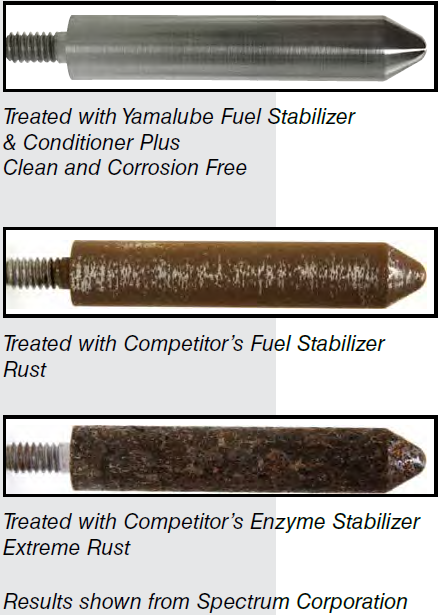E10 Fuel (better known as 10% ethanol-blended gasoline) – whether we
like it or not, it is here to stay.
Adding ethanol to fuel helps reduce emissions for cleaner air. Unfortunately,
ethanol is also tough on many engine components, which can end
up causing a strain on your wallet. Performing some simple maintenance
steps can help protect your machine against E10 damage.
Using today’s E10 fuels means giving your machine more attention and
maintenance than when the previous MTBE fuels were used because
there can be some problems, particularly with the fuel system. When
these E10 problems first emerged, many companies jumped on the
ethanol treatment band wagon, feeding off of consumer fears about the
potential damage. Most of these treatments have proven to be a waste of
money.
Now for some good news:
Yamalube has researched the root problems our customers are facing with
ethanol fuels. We simply didn’t want an unproven “Ethanol Treatment”
because there really is no “treatment” for ethanol –you cannot change its
natural characteristics. But you can “control” these characteristics, which
is why we developed a “Total Ethanol Care Package”: Yamalube Fuel Stabilizer
& Conditioner Plus.
Yamalube Fuel Stabilizer & Conditioner Plus
Ethanol-blended fuel starts to go bad from the day it is produced. It begins
oxidizing and starts absorbing water from the air, which can eventually
lead to phase separation. Adding Yamalube Fuel Stabilizer & Conditioner
Plus works to prevent fuel oxidation and water absorption. The key
is to add the fuel stabilizer right when you fill up to lock in the performance
of the fuel then and there. Don’t wait even a few days to add the stabilizer
because the fuel will have already degraded and absorbed water from the
air since you purchased it.
Ethanol can also contain harmful sulfate salts that can attack metals in the
fuel system. Our new, exclusive formula controls the potential for corrosion
because it is fortified with metal filmers that no other brand in the
market has to protect steel and aluminum components.
As you see from the pictures from a testing lab, we placed our new Fuel
Stabilizer & Conditioner Plus up against some very well-known aftermarket
products. The results speak for themselves. Why would you use
a product from a company that doesn’t have a stake in protecting its
engines?

Yamalube Fuel Stabilizer & Conditioner Plus is an alcohol-free fuel
additive that is designed to “stabilize” the fuel by locking in the “freshness,”
prevent oxidation, prevent water absorption, and protect against
harmful gums and varnishes, in addition to protecting the fuel system
metals from the harmful corrosive effects of ethanol-blended fuel.
Yamalube recommends the following maintenance procedures for
E10 gasoline:
1) Always add Fuel Stabilizer & Conditioner Plus each time the fuel
tank is filled.
2) Operate the machine frequently to keep fuel fresh.
3) Check and replace fuel filters frequently, especially when ethanol
fuels are first introduced in the area.
4) Buy fuel from the same reputable source, preferably one who has a
lot of business so their fuel supplies move quickly.
Off-Season Storage:
1) During your last trip of the season before storage, add the stabilizer
in the storage concentration specified on the bottle. This will let the
treated fuel circulate completely through the fuel system.
2) For storage, fill fuel tank to 7/8 full with treated fuel. This helps
prevent corrosion of the fuel tank and leaves very little air
space, reducing the risk of condensation.
3) Except for fuel-injected engines, drain the carburetor float bowl or
any other small chamber exposed to air that has fuel.
Yamaha recommends using Fuel Stabilizer & Conditioner Plus on a continuous
basis, which is a treat rate of 1 ounce to 3 gallons of fresh fuel.
This averages just about $0.12 per gallon. That’s a small price to pay,
because once fuel goes bad there is nothing in the marketplace that
will make it usable again. Running bad gas through an engine risks
expensive repair costs.
32oz Bottle Link
12oz Bottle Link
Portions of this article are republished from the Yamaha On Board Magazine with full permission from Yamaha Motor Corp USA
Some of these comments and suggestions are from SIM Yamaha and do not reflect, nor are they intended to represent, any position from Yamaha Motor Corp USA. SIM Yamaha freely offers this advice based on our years of experience selling Yamaha outboard engines, replacement parts and servicing Yamaha outboards. Our primary goal is to give you the information you need to properly maintain your Yamaha outboard engine.